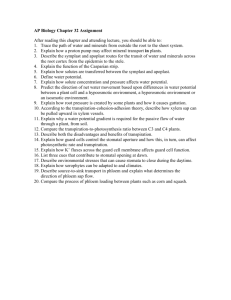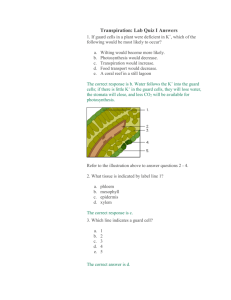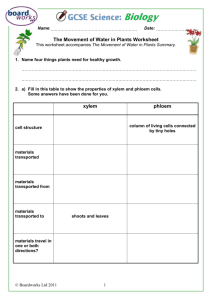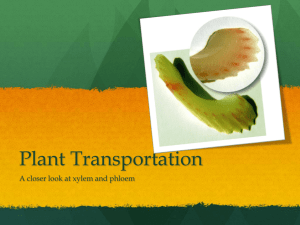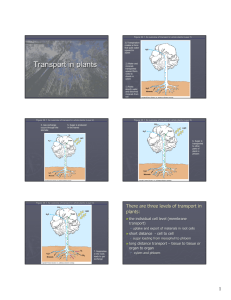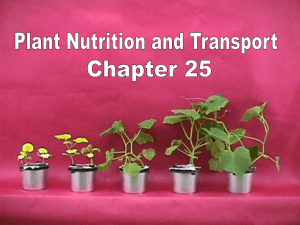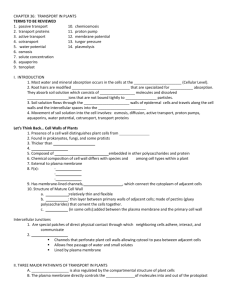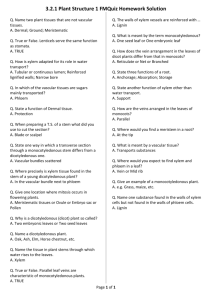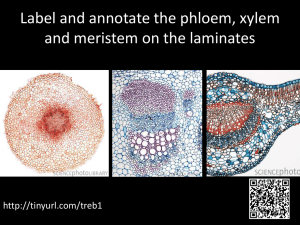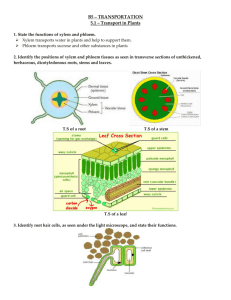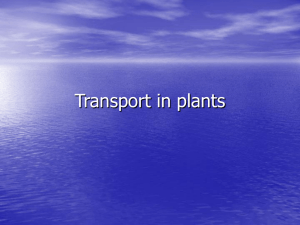ANSWERS TO REVIEW QUESTIONS – CHAPTER 17
advertisement
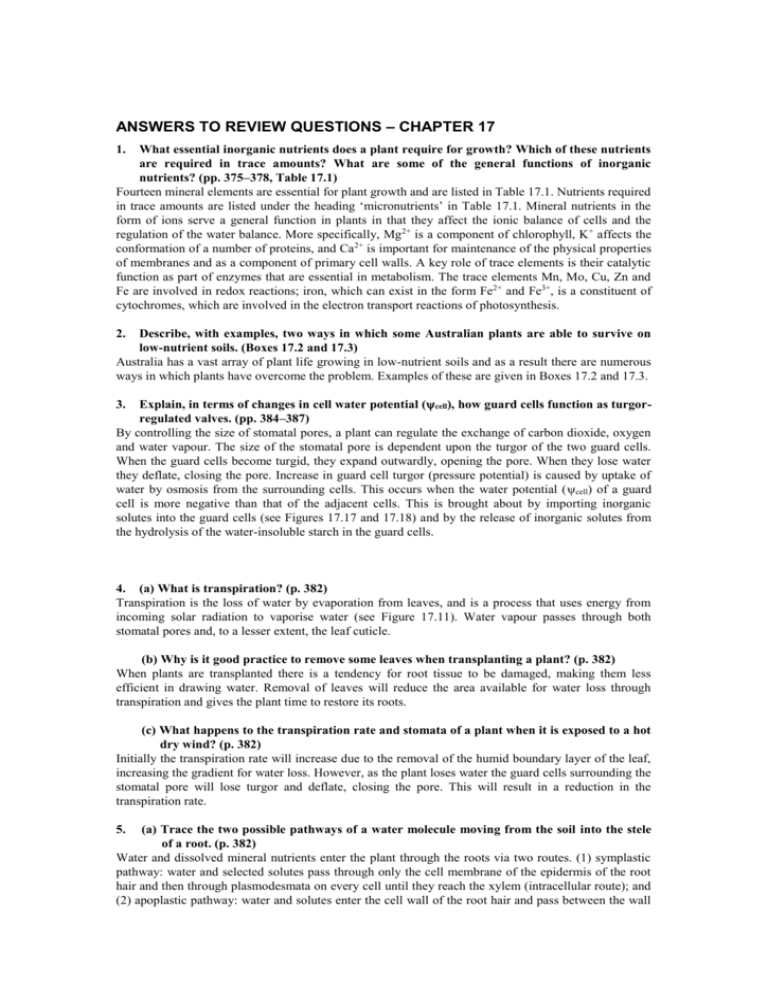
ANSWERS TO REVIEW QUESTIONS – CHAPTER 17 1. What essential inorganic nutrients does a plant require for growth? Which of these nutrients are required in trace amounts? What are some of the general functions of inorganic nutrients? (pp. 375–378, Table 17.1) Fourteen mineral elements are essential for plant growth and are listed in Table 17.1. Nutrients required in trace amounts are listed under the heading ‘micronutrients’ in Table 17.1. Mineral nutrients in the form of ions serve a general function in plants in that they affect the ionic balance of cells and the regulation of the water balance. More specifically, Mg2+ is a component of chlorophyll, K+ affects the conformation of a number of proteins, and Ca2+ is important for maintenance of the physical properties of membranes and as a component of primary cell walls. A key role of trace elements is their catalytic function as part of enzymes that are essential in metabolism. The trace elements Mn, Mo, Cu, Zn and Fe are involved in redox reactions; iron, which can exist in the form Fe2+ and Fe3+, is a constituent of cytochromes, which are involved in the electron transport reactions of photosynthesis. 2. Describe, with examples, two ways in which some Australian plants are able to survive on low-nutrient soils. (Boxes 17.2 and 17.3) Australia has a vast array of plant life growing in low-nutrient soils and as a result there are numerous ways in which plants have overcome the problem. Examples of these are given in Boxes 17.2 and 17.3. 3. Explain, in terms of changes in cell water potential (cell), how guard cells function as turgorregulated valves. (pp. 384–387) By controlling the size of stomatal pores, a plant can regulate the exchange of carbon dioxide, oxygen and water vapour. The size of the stomatal pore is dependent upon the turgor of the two guard cells. When the guard cells become turgid, they expand outwardly, opening the pore. When they lose water they deflate, closing the pore. Increase in guard cell turgor (pressure potential) is caused by uptake of water by osmosis from the surrounding cells. This occurs when the water potential (cell) of a guard cell is more negative than that of the adjacent cells. This is brought about by importing inorganic solutes into the guard cells (see Figures 17.17 and 17.18) and by the release of inorganic solutes from the hydrolysis of the water-insoluble starch in the guard cells. 4. (a) What is transpiration? (p. 382) Transpiration is the loss of water by evaporation from leaves, and is a process that uses energy from incoming solar radiation to vaporise water (see Figure 17.11). Water vapour passes through both stomatal pores and, to a lesser extent, the leaf cuticle. (b) Why is it good practice to remove some leaves when transplanting a plant? (p. 382) When plants are transplanted there is a tendency for root tissue to be damaged, making them less efficient in drawing water. Removal of leaves will reduce the area available for water loss through transpiration and gives the plant time to restore its roots. (c) What happens to the transpiration rate and stomata of a plant when it is exposed to a hot dry wind? (p. 382) Initially the transpiration rate will increase due to the removal of the humid boundary layer of the leaf, increasing the gradient for water loss. However, as the plant loses water the guard cells surrounding the stomatal pore will lose turgor and deflate, closing the pore. This will result in a reduction in the transpiration rate. 5. (a) Trace the two possible pathways of a water molecule moving from the soil into the stele of a root. (p. 382) Water and dissolved mineral nutrients enter the plant through the roots via two routes. (1) symplastic pathway: water and selected solutes pass through only the cell membrane of the epidermis of the root hair and then through plasmodesmata on every cell until they reach the xylem (intracellular route); and (2) apoplastic pathway: water and solutes enter the cell wall of the root hair and pass between the wall and plasma membrane (extracellular route) until they encounter the endodermis, a layer of cells that they must pass through to enter the xylem. However, combinations of these pathways may result in several possible routes, although all water must pass through the cells of the endodermis (symplastic route) in order to reach the xylem vessels. (b) By what process do roots take up ions? (p. 382) Ions are taken up in the root as a dilute solution in water and follow the same pathway as the water molecules. 6. Explain how soil water can be transported to the top of a tall tree. What special features of xylem enable this to occur? (p. 383) The driving force for mass flow of sap in xylem is a gradient of water potential, which is increasingly negative towards the leaf and air, ‘pulling’ the xylem fluid up. The nature of the xylem vessels allows the water column to extend above 10 metres. This is because xylem vessels are very narrow and molecular forces will hold water molecules together and to the sides of the vessels (capillary attraction), resulting in a column of water under tension. Removal of water by evaporation in leaves at the top of the column results in a flow of water from the roots through a plant. This is called the cohesion theory. 7. What is the composition of phloem sap and how is it different from that of xylem sap? (p. 388) Phloem sap is a concentrated solution of solutes (Figure 17.24), predominantly organic sucrose at a concentration of about 0.5 M. Xylem sap is the liquid contained as a continuous column in the tracheids and vessels of xylem. It is a dilute solution of inorganic ions and some organic nitrogen compounds. 8. Explain the mechanisms by which assimilates are translocated in phloem from a source to a sink. (pp. 389–390) Translocation of assimilates (sucrose) from a source (e.g. leaf mesophyll) to a sink (e.g. growing roots) involves three processes: (1) phloem loading, i.e. active transport (against a concentration gradient of sucrose) from the mesophyll to the sieve tubes in the veins of a leaf (see Figure 17.26); (2) longdistance transport of sucrose in the stem and root phloem by mass flow driven by a gradient of hydrostatic pressure (see Figure 17.27); and (3) phloem unloading, i.e. passive transport (down a sucrose gradient) from the sieve tubes to the cells at the root tip. 9. Explain why salt makes soil water less available to a plant and has similar effects to a drought. (pp. 394–395) In order for plants to draw water they need to have a lower water potential (more negative) than the soil water. High salt concentrations in the root zone of a plant lower soil water potential, making it difficult for plants to draw water, leading to water stress. 10. What is the role of the hormone ABA during prolonged periods of water stress? (pp. 387, 394, 397–398) ABA (abscisic acid) causes osmotic solute efflux from the guard cells, resulting in loss of turgor and thus closure of the stomatal pore. In the early stages of drought plants generate an ABA signal in their roots. This hormone travels into the xylem stream to the leaves, resulting in rapid closure of the stomata. This has the effect of conserving soil water, which is important for survival during drought.
